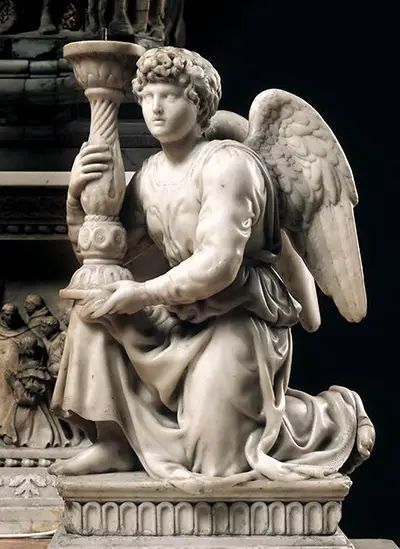Other artists such as Nicole Pisano had, in the 13th century, worked on the scheme while in the 15th century, Niccolodell’Arca managed the project. At this time, there was already the presence of an angel holding a candlestick.
There is a contrast between the two works. The earlier version has a delicate child clothed in Gothic robes while Michelangelo’s depicts a strong youth with the wings of an eagle.
After Michelangelo relocated to Rome in 1948 at the age of 25, he designed a sculpture of Mary holding her dead son Jesus on her lap. It was then erected at the tomb of the then Cardinal Jean Bilheres de Lagraulas.
The statue, which stands at six feet tall and wide, has so far, been moved five times. Today it is at St. Peter’s Basilica in the Vatican City. The Pieta is today a revered piece of work that was carved from one piece of Carrara marble. When he overheard pilgrims attribute his work to another artist, he quickly carved his signature across Mary’s chest.
In 1501 the artist returned to Florence where he created a huge male figure from marble to bring out the city’s famous Duomo. In his sculpture, he depicted David as heroic, spiritual and powerful at 17 feet tall. Considered to be technically perfect by scholars, it sits at the Galleria dell'Accademia in Florence. The sculpture is an artistic heritage and a famous symbol of the city.
Widely known as Michelangelo, Lodovico Buonarroti Simon was born on 6th March 1475 in Caprese Italy. Although he later died in 1564, he was considered as one of the greatest sculptor, architect, poet and painter of all time who had a lot of influence on the development of the western art. Most of his works in sculpture, architecture and painting are today ranked as some of the most famous in existence.
His works brought out a blend of physical realism, psychological insight and intensity not seen before. His extraordinary talent was recognised by the wealthiest and most influential men of his time such as popes and those affiliated with the Roman Catholic Church. This earned him commissions. Most of his works, especially the Sistine Chapel ceiling paintings and David and Pieta have long been preserved to allow the future generations to view and appreciate what was done.
Early Success and Influence
Michelangelo grew up in Florence during a period where there was a vibrant arts centre. This is what particularly inspired his talent, and as a result, it developed and flourished. His mother, who was a great supporter of his love for art, died when he was 6. Although his father never approved of his interests in art, Michelangelo was lucky enough to be apprenticed to Domenico Ghirlandaio who was a great painter.
After about one year, his talent attracted the attention of the art patron Lorenzo de Medici who invited him to reside in one of his rooms. Michelangelo was strongly inspired by the greatest writers and scholars in Lorenzo’s circle, and this gave him a lot of insight into his works in terms of politics and philosophy.
The Sistine Chapel Ceiling Painting
Michelangelo was, in 1505, commissioned to sculpt a grand tomb by Pope Julius II. As the Pope became involved with military disputes, he shifted his priorities from the project. This led to the scarcity of funds, and Michelangelo angrily left Rome. He was regarded as short-tempered during this time because, after he had returned to Florence, he wrote a rude letter to the pope emphasising on his displeasure. In the letter, he asked the pope to look for him if he still needed his services. The pope did not lose his temper over the rush words but rather persuaded the sculptor to return to Rome.
In the course of his four-year project in Rome, Michelangelo painted 12 figures, seven of which were prophets and five sibyls. In the central space of the ceiling, he included scenes from Genesis. Critics say that the way Ezekiel is depicted brings him out as strong but stressed and unsure. The most outstanding painting in the chapel is the creation of Adam where God and Adam are seen to stretch their hands out to each other.
Architecture, Poetry and Morality
Michelangelo was a painter and a sculptor until his death, although towards this time, he worked more on architecture. The work done between 1520 and 1527 in the Medici Chapel included cornices, windows, and wall designs that appeared unusual in both design and proportion. The other masterpieces he designed included the Moses sculpture, which was completed in 1515, the last judgement painting finished in 1534 and 1533, day, dawn, night and dusk sculptures.
From 1530, he took up poetry many of the pieces, which incorporated the Neo-Platonism philosophy. The poetry described how with love and ecstasy, a human soul could reunite with God. The ideas brought out in his poetry were inspired by the discussions that took place in Lorenzo de Medici’s home during his teenage life. He was then crowned chief architect of the unfinished St. Peter’s Basilica in 1546.
After a short ailment, he died at the age of 88, which was beyond the life expectancy during his time. Before his death, he had begun sculpting a Pieta, which he intended to have placed on his grave. Unfortunately, he had not finished sculpting it, but it is currently on display in Florence at Museodell’Operadel Duomo.
Image of Angel
The image featured in this page is used under the Creative Commons Attribution 3.0 Unported license and was resized. The original contributer was Sailko, via Wikimedia.


